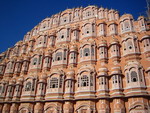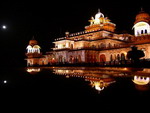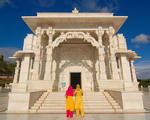
|
CHINA> About India
 |
|
Travel in India
(Wikipedia)
Updated: 2009-09-14 17:53 Travel in Jaipur
 Jaipur, also popularly known as the Pink City, is the capital of Rajasthan state, India. Jaipur is the former capital of the princely state of Jaipur. Founded on 18 November 1727 by Maharaja Sawai Jai Singh II, the ruler of Amber, the city today has a population of more than 5 million residents.
 Jaipur is the first well planned city of India, located in the desert lands of India, Rajasthan. The city which once had been the capital of the royalty now is the capital city of Rajasthan. The very structure of Jaipur resembles the taste of the Rajputs and the Royal families. In the present date, Jaipur is the major business centre for the natives of Rajasthan with all requisites of a metropolitan city.
 The city is remarkable among pre-modern Indian cities for the width and regularity of its streets which are laid out into six sectors separated by broad streets 111 ft (34 m) wide. The urban quarters are further divided by networks of gridded streets. Five quarters wrap around the east, south, and west sides of a central palace quarter, with a sixth quarter immediately to the east. The Palace quarter encloses a sprawling palace complex (the Hawa Mahal, or palace of winds), formal gardens, and a small lake. Nahargarh Fort crowns the hill in the northwest corner of the old city. Another noteworthy building is Sawai Jai Singh's observatory, Jantar Mantar.
Travel in Mumbai
The seven islands that came to constitute Bombay were home to communities of fishing colonies. For centuries, the islands came under the control of successive kingdoms and indigenous empires before being ceded to Portuguese settlers and subsequently to the British East India Company. During the mid-18th century, Bombay emerged as a significant trading town. Economic and educational development characterised the city during the 19th century. It became a strong base for the Indian independence movement during the early 20th century. When India became independent in 1947, the city was incorporated into Bombay State. In 1960, following the Samyukta Maharashtra movement, a new state of Maharashtra was created with Bombay as the capital. It was renamed Mumbai in 1996. Mumbai is the commercial and entertainment centre of India, generating 5% of India's GDP, and accounting for 25% of industrial output, 40% of maritime trade, and 70% of capital transactions to India's economy. Mumbai is home to important financial institutions such as the Reserve Bank of India, the Bombay Stock Exchange, the National Stock Exchange of India and the corporate headquarters of numerous Indian companies and multinational corporations. The city also houses India's Hindi film and television industry, known as Bollywood. Mumbai's business opportunities, as well as its potential to offer a higher standard of living, attract migrants from all over India and, in turn, make the city a potpourri of many communities and cultures. |